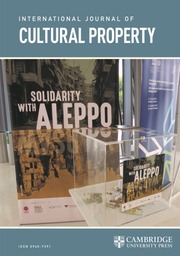No CrossRef data available.
Article contents
Safeguarding public collections: A new approach to the recovery of cultural objects unlawfully removed from state ownership
Published online by Cambridge University Press: 01 August 2025
Abstract
In this study, we argue that uncovering losses from public collections and making efforts to recover them is of fundamental importance concerning the responsible management of state assets and the maintenance of the cultural public interest. In recent times, the perception of museums has been in a constant state of flux, with international expectations associated with them sometimes appearing to be contradictory. While much attention has been paid to the diligence of care, museums must exercise in areas such as acquisition, deaccessioning policies, repatriation, and decolonization, an equally important function – but one less discussed in the international literature – which is the duty of public collections to safeguard and manage state-owned assets. In 2023, the Hungarian National Museum implemented a new initiative aimed at recovering cultural property that had disappeared from public collections under unknown circumstances. This procedure has already generated numerous insights that the current study analyzes, ranging from the difficulty of shedding light on decades-long ownership chains to the challenges of acquisition and the effectiveness of dispute resolution. The Hungarian initiative represents an additional approach to the protection of cultural property, addressing a significant gap in the Hungarian heritage protection system that has received less attention.
Keywords
Information
- Type
- Article
- Information
- Copyright
- © The Author(s), 2025. Published by Cambridge University Press on behalf of International Cultural Property Society


